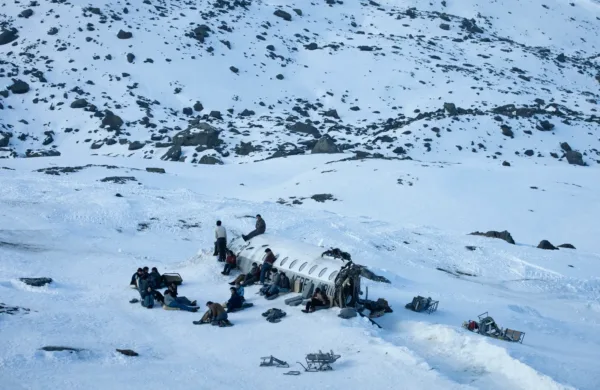Many of us know the story of the 1972 Uruguayan rugby team whose plane crashed in the Andes. Some of our parents and grandparents remember when it happened, particularly the ones who are Iberoamerican. We knew that the most devastating part of the story was that they ended up having to eat the dead to stay alive. Yet, aware of our understanding of the story, director J.A. Bayona still decided to create a movie about it (the third one in existence). Armed with the trust that he could bring something different to the screen, he created a masterpiece.
Bayona’s approach is about bringing new life to the story, and a sense of compassion that we had not experienced before. He wanted the audience to really feel what the characters were going through, which he thought required exposing the actors to a similar situation to the survivors. As such, the actors filmed in Sierra Nevada and in the Andes near the real sight of the crash, wore minimal clothing, and restricted their eating. They were forced to be constantly cold and hungry. Within a few months, the actors had lost 30kg each for their roles, creating a huge real physical transformation from the beginning to the end of the movie. Their suffering in the movie looks real because a lot of it is.
The actors did not shy away from putting themselves in the characters’ shoes as much as possible, in turn creating a much stronger bond between the actors and the characters they were playing. Consequently, as they had much more compassion for the characters, so did the viewer. Bayona forces you to feel what they are going through, to the point where viewers explain that they feel real coldness when they watch the film. This makes the experience much more harrowing.
Bayona also relies on the scenery to depict the experience. By filming scenes at the site of the crash, they could illustrate the vastness of the landscape as realistically as possible, rather than relying too much on editing. In one of the most pivotal scenes in the movie, the team had just found a radio and managed to make it work. When they get a signal and listen to the news, they hear that airplanes have stopped looking for their crashed plane in rescue missions. As the characters cry and scream, the radio transmission switches to a commercial for bicycles, and the camera zooms out to show the mountains.

The happy, aloof commercial contrasts perfectly with the chilling cries of the survivors, thereby emphasizing the pain that they were going through. The commercial even seems obnoxious, making you wonder how society can go on while allowing their horrific experience to continue. This purposeful irony is enhanced by the zoom-out to show the massive, uninhabitable landscape. It reminds you of the uselessness of a human being in that situation, and how something as mundane as a bicycle can make them feel so distant from civilization.
While all of these elements are key to the film, the directorial choice that truly makes this a historic movie is choosing the film’s narrator. For a long time, the movies and books made about the story wedged a gap between the surviving and the dead, making their families drift apart and the story focus only on the survivors. While the 16 survivors did something incredible and their stories should be heard, Bayona knew that the real heroes of the story were those who lost their lives on the mountain. In an unconventional decision, he thus made one of the dead, a 25-year-old named Numa Turcatti, the narrator and protagonist of the story.
Not only was Numa described as one of the greatest people all of the players had ever met, he lost his life trying to save his friends, not himself. Throughout the movie, he is the most selfless and generous of all, and he gives his life for his friends to be able to live theirs. Bayona made him the narrator to show that the survivors are incredible people, but so were the dead, and the survivors would not have made it without them. The choice of narrator bridged the gap between those who returned and those who did not – something that no one had been able to do before.
These elements make the movie what it is – beautiful and haunting. Some of the scenes in this film are the toughest you will ever have to sit through, from the plane crash to seeing the illnesses they develop. It is not a movie that you will feel comfortable watching, and I honestly do not recommend watching it right before you go to sleep. But it is worth it. It is worth it because you come out of it a better person, and that is what good movies do.
Feature image: ABC




